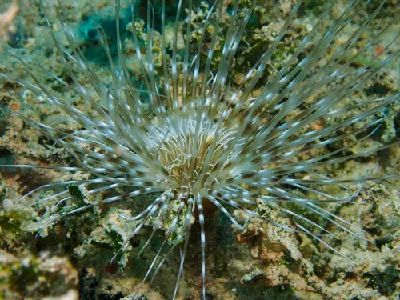Banded Tube Dwelling Anemone
Pachycerianthus maua
The Banded Tube (Pachycerianthus maua), also known as the Tube Anemone or Tube Dwelling Anemone, is a species characterized by its long, soft, cylindrical body, pointed foot, crown of tentacles, and tube. With a diameter of approximately 8 inches (20 cm) and tentacles that extend up to 30 cm (12 inches), this anemone burrows deep into sandy or muddy substrates to construct a hard tube for habitation.
Indigenous to areas such as 🇮🇩 Indonesia, Lembeh Strait, Sulawesi and 🌊 Red Sea this nocturnal species lacks zooxanthellae and ventures out from its tube during nighttime hours to feed on zooplankton, which is more abundant during this period. Found in small groups in shallow sandy coastal areas at depths ranging from 5 to 30 m (15 to 100 feet), the Tube Anemone primarily consumes zooplankton but also preys on small fishes.
Notably, the Rainbow Nudibranch Dendronotus iris is the sole known predator of the Tube Anemone. However, this nudibranch does not kill its prey entirely, but rather consumes portions and leaves enough behind for the anemone to regenerate. Additionally, the ectoparasitic copepod Myxomolgus hoi uses the Pachycerianthus maua as its host.
The name "tube anemone" originates from its remarkable ability to construct a tube as its dwelling. It was previously believed that they formed the tube by releasing mucus that accumulated sand. However, it is now known that they create the tube by releasing threads of a specific type of nematocysts called "ptychocyst." This results in a woven fibrous structure with stinging cells that provide protection against threats. Though its tentacles are non-retractable, the Tube Anemone can quickly withdraw its entire body into the tube for safety when startled or disturbed.
It is worth noting that tube anemones from the Pachycerianthus genus are capable of moving across the sea floor using their tentacles. They can cover distances of over 3 feet until they locate a suitable spot to burrow again. Alternatively, they may inflate themselves and allow the current to carry them.
Comments
Please, sign in to leave comment
No Comments yet
Last Update: May 28, 2025

